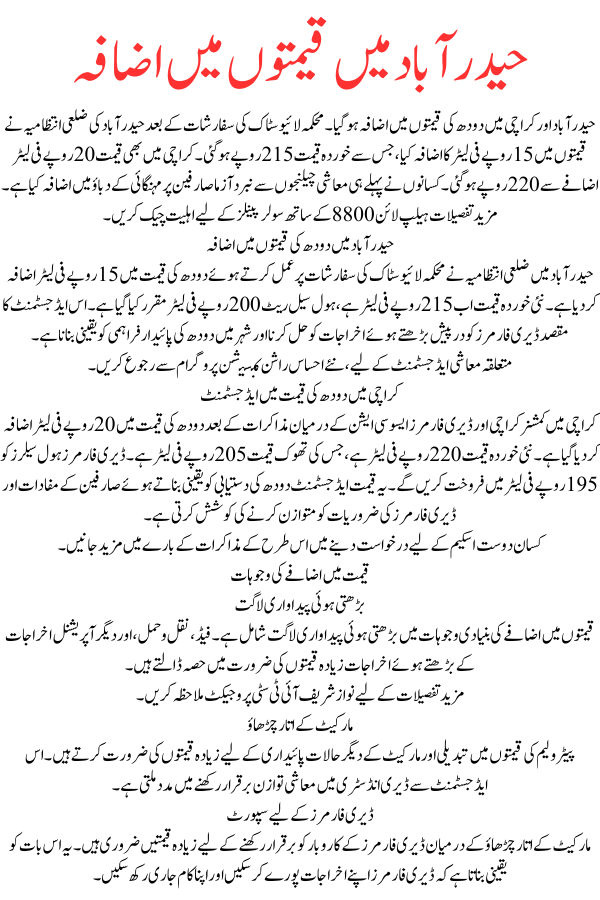Milk Price Increase in Hyderabad and Karachi
The recent surge in milk prices in Hyderabad and Karachi has significant implications for consumers and dairy farmers. Both cities’ administrations have issued new notifications detailing the price adjustments. This article delves into the reasons behind the hikes, the impact on different stakeholders, and the government’s role in regulating these changes.
For insights into similar economic impacts, see Pakistan New Green Meter Tax Policy.
Price Increase in Hyderabad
Milk prices have surged in Hyderabad and Karachi. Following recommendations from the Livestock Department, Hyderabad’s district administration increased prices by Rs 15 per liter, bringing the retail price to Rs 215. Karachi’s price was also hiked by Rs 20 per liter to Rs 220. These increases, attributed to rising input costs for dairy farmers, have added to inflationary pressures on consumers already grappling with economic challenges.
More details can be found in the Check Eligibility for Solar Panels with Helpline 8800.
Hyderabad’s Milk Price Hike
In Hyderabad, the district administration, following recommendations from the Livestock Department, has raised the price of milk by Rs 15 per liter. The new retail price is now Rs 215 per liter, with the wholesale rate set at Rs 200 per liter. This adjustment aims to address the rising costs faced by dairy farmers and ensure a sustainable milk supply in the city.
For related economic adjustments, refer to the The New Ehsaas Ration Concession Program.
Karachi’s Milk Price Adjustment
In Karachi, after negotiations between the Commissioner of Karachi and the Dairy Farmers Association, the price of milk has been increased by Rs 20 per liter. The new retail price is Rs 220 per liter, with the wholesale price at Rs 205 per liter. Dairy farmers will sell to wholesalers at Rs 195 per liter. This price adjustment seeks to balance consumer interests and dairy farmers’ needs while ensuring milk availability.
Learn more about such negotiations in the Applying for the Kisan Dost Scheme.
Reasons for the Price Increase
Rising Production Costs
The primary reasons for the price increase include rising production costs. Increased costs of feed, transportation, and other operational expenses contribute to the need for higher prices.
For more details, visit the Nawaz Sharif IT City Project.
Market Fluctuations
Changes in petroleum prices and other market conditions necessitate higher prices for sustainability. This adjustment helps maintain the economic balance in the dairy industry.
Support for Dairy Farmers
Higher prices are essential to sustain dairy farmers’ businesses amidst fluctuating market conditions. This ensures that dairy farmers can cover their costs and continue their operations.
Further information can be found in the TEVTA Short Courses in Lahore Admission Form.
Impact on Consumers
Direct Financial Impact
The price increase has several implications for consumers. Households, especially those with tight budgets, will feel the pinch of higher milk prices.
For more on consumer impacts, see the NAVTTC Skill Verification Program.
Consumption Adjustments
Consumers may need to allocate more of their budget to milk, potentially affecting other areas of spending. As milk is a staple in many households, higher prices might lead to reduced consumption or adjustments in diet.
Impact on Dairy Farmers
Covering Rising Costs
For dairy farmers, the price increase is crucial. The new prices help farmers manage increased production costs and ensure a sustainable income.
For insights into similar economic measures, visit the 5kV Solar Scheme Started by Maryam Nawaz.
Business Viability
The adjustment is essential for maintaining the viability of dairy farming operations. This ensures a continued supply of milk to the market, benefiting both farmers and consumers.
Government and Regulatory Measures
Price Regulation
The government and regulatory bodies have taken several steps to manage the new prices. Agreements with dairy farmers in Karachi ensure compliance with official prices.
For more on regulatory measures, refer to the Pakistan New Green Meter Tax Policy.
Transparency and Monitoring
Sellers must display purchase and sale rates clearly to prevent unauthorized price increases. Regulatory measures are in place to ensure fair practices in the market and adherence to set prices until December 31.
Conclusion
The recent price hikes in Hyderabad and Karachi highlight the complex dynamics between production costs, market demands, and consumer needs. While the increases are challenging for consumers, they are necessary to support dairy farmers and maintain a stable milk supply. Government interventions and regulatory measures play a crucial role in balancing these interests and ensuring fair practices in the market.
FAQs
- Why have milk prices increased in Hyderabad and Karachi?
- The primary reasons include rising production costs, market fluctuations, and the need to support dairy farmers.
- What are the new prices in Hyderabad and Karachi?
- In Hyderabad, the price is Rs 215 per liter, and in Karachi, it is Rs 220 per liter.
- How does the price increase affect consumers?
- Consumers, especially those with tight budgets, will face higher expenses for milk, potentially impacting their overall spending.
- What measures have been taken to regulate prices?
- The government has agreements with dairy farmers, requires sellers to display prices, and has regulatory measures to ensure fair practices.
- How does the price increase benefit dairy farmers?
- The new prices help dairy farmers manage increased production costs and ensure a sustainable income.
- What are the wholesale prices in Karachi?
- The wholesale price in Karachi is Rs 205 per liter, with dairy farmers selling to wholesalers at Rs 195 per liter.
- How do rising production costs affect prices?
- Increased costs of feed, transportation, and other operational expenses lead to higher milk prices to cover these costs.
- What is the role of the Livestock Department in the price adjustment?
- The Livestock Department recommends price adjustments to address rising costs and ensure a sustainable milk supply.
- What should consumers do in response to the price increase?
- Consumers may need to adjust their budgets and spending to accommodate higher milk prices.
- How long will the regulatory measures for prices be in place?
- The regulatory measures are set to ensure adherence to prices until December 31.


